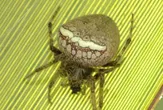Harmful Effects of Signature spider
A species of Garden orbweb spinner
Health risks from signature spider are minimal, with bites being rare and typically only occurring if threatened. Transmission is through venom injection via bites, causing mild, bee-sting-like symptoms that are not life-threatening and may require minor medical treatment.
Is the Signature spider poisonous?
Does the Signature spider bite humans or animals?
Harmful Facts About Signature spider









AI entomologist in your pocket
Scan QR code to download

